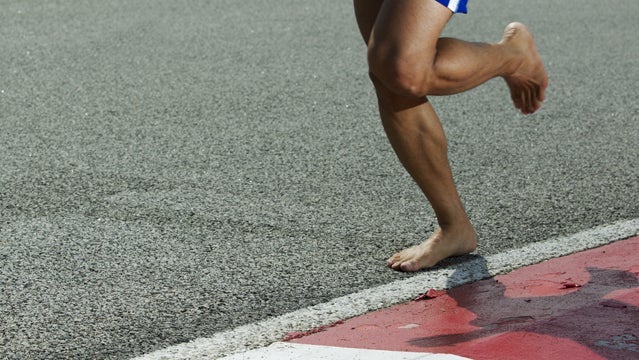Making the Switch to Minimalist Running

(Photo: Stuart Jenner )
The debate between traditional running shoes and the growing minimalist movment rages on. For those of you who are thinking of trying out a minimalist shoe, or even going barefoot, there’s a few things you should keep in mind…
1. If you want to alleviate a chronic injury.
Worth a try: Shoes that put you closer to the ground make it easier to stay in a good running position, which can lessen stress on your musculoskeletal system and help you break the injury cycle.
Bear in mind: Shoes are a tool, not a magic bullet. A history of chronic injury indicates underlying weaknesses and imbalances that probably warrant strength and flexibility work, and possibly professional attention.
2. If you want to get back into running.
Worth a try: If you’ve been away from it for a while, you’ll probably be a cleaner bio-mechanical slate than habitual runners, and your body might more easily adapt to how minimalist shoes encourage it to run. Also, you’ll start at low mileage and progress gradually, further helping your body adjust to minimalist shoes.
Bear in mind: Good running form—a light, quick cadence and good postural alignment—doesn’t come naturally. And if you’re carrying extra weight, the lack of cushioning could make returning to running a shock to your body.
3. If you want to go faster.
Worth a try: Most people adopt a higher cadence when they switch to lighter, lower shoes, which can make you faster. Research shows that, up to a point, the lighter your shoes, the better your running economy.
Bear in mind: How fast yourun is determined by the length and rate of your stride. If you already have a decent cadence—somewhere between 165 and 180 steps per minute—increasing it a bit with minimalist shoes might not mean going faster, because your stride length will decrease. Put another way, two times three and three times two both equal six.
4. If you want to make running more enjoyable.
Worth a try: We all have a sweet spot where a shoe provides the right amount of structure for our makeup and otherwise gets out of the way. There’s no reason to think that a thickly cushioned, high-heeled model will get you there. You might just feel better in less shoe.
Bear in mind: If you’re used to nothing but heavy, heeled running shoes, being closer to the ground with less cushioning is likely to feel weird for a month or more. You’ll be more aware of each foot strike and less able to zone out on a run. And you may find that you like running in your old shoes better.
5. You want to see what all the fuss is about.
Worth a try: One of the great things about minimalism is its emphasis on running being a natural activity, not something we dare do only in feature-laden, highly engineered shoes that “protect” and “support” us.
Bear in mind: Have we mentioned that shoes aren’t a magic bullet? Your success as a runner depends on the interplay of numerous factors, including body strength and alignment, training consistency, mindset, and diet.